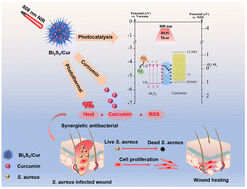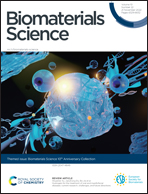Sea urchin-like Bi2S3/curcumin heterojunction rapidly kills bacteria and promotes wound healing under near-infrared light†
Abstract
Bacterial infection is an urgent public health problem. We design a novel photo-responsive hybrid material by growing small molecules of curcumin (Cur) in situ on a sea urchin-like Bi2S3 surface by a one-step hydrothermal reaction method, thus forming an organic–inorganic hybrid material with interfacial contact. The Bi2S3/Cur hybrid material has good antibacterial effect under 808 nm near-infrared (NIR) light irradiation. The antibacterial mechanism is that the electron redistribution at the interface of Bi2S3/Cur excited by 808 nm NIR light will cause a large number of electrons to gather on the side of Bi2S3, forming an internal electric field to drive the excited electrons from Bi2S3 to Cur, which accelerates the separation of photoexcited electron–hole pairs and enhances the production of reactive oxygen species (ROS). In conclusion, due to these synergistic effects of the photothermal properties of Bi2S3, the production of more ROS and the release of small molecules of Cur from traditional Chinese medicine in Bi2S3/Cur, the antibacterial efficacy against Staphylococcus aureus (S. aureus) and Escherichia coli (E. coli) is 99.96% and 99.03%, respectively. In vivo experiments in animals show that Bi2S3/Cur can reduce the inflammatory response and promote wound healing. This paper presents a simple, rapid and safe strategy for the treatment of wound infections with near-infrared light.

- This article is part of the themed collection: Biomaterials Science 10th Anniversary Collection


 Please wait while we load your content...
Please wait while we load your content...